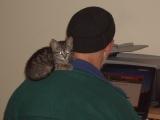Apologists for Israel frequently accuse the Palestinians of resorting to violence against Israeli civilians as a matter of preference. 'If they would only learn from Martin Luther King and Mahatma Gandhi, they'd have achieved everything they could possibly want by now. But as long as they insist on terrorising innocent heavily armed Israeli civilians, the Jewish state must of course deploy maximum force to protect its helpless citizens. The only possible alternative is to allow the bloodthiursty Arabs carry out the second Holocaust they have always longed for.' You know the kind of thing.
There is a number of responses to these accusations. The most obvious is that Israel could, in accordance with its fabled 'purity of arms', practice a little less ultraviolence itself. Then perhaps the Palestinian retaliation would take different forms. Jonathan Cook points out that in reality, Palestinian acts of nonviolent resistance, large and small, public and private, are going on all the time. Every week at the Apartheid Wall in Bil'in and every time a child evades a checkpoint to get to school, what we are witnessing is nothing other than nonviolent resistance. But these actions somehow don't attract the international media. So they can engage in nonviolent resistance and nobody even notices, or they can engage in violence and earn the opprobrium of the civilised world. Heads Israel wins, tails the Palestinians lose.
In his article in The Socialist Register 2008: Global Flashpoints: Reactions to imperialism and neoliberalism, that appeared on Znet last week, Bashir Abu-Manneh, citing Cheryl Rubenberg, makes a point that frankly hadn't occurred to me.
The nature of the second Intifada was very different than the first, however. One of Oslo’s practical consequences was that the Israeli army had redeployed outside major population concentrations, making it extremely difficult for enclaved Palestinians to get at or confront the occupation forces, unlike in the first Intifada. Being fragmented by checkpoints and confined to their locales ‘rendered mass action virtually impossible’. Reflecting the effects of the siege regime through the 1990s, there has thus been a systematic weakening of the capacity of Palestinian society to act and organize as a national collective. As Rema Hammami and Salim Tamari argue, Oslo destroyed all resources for civil rebellion:
Save for massive candlelight marches and funeral processions within the cities, the population at large has been left with virtually no active role in the uprising. This is clearly not by choice, but as a consequence of the fact that the kinds of political structures that made grass-roots organizing the main thrust of the first intifada, at least in the early years, no longer exist. Popular and neighborhood committees as well as mass organizations (and most of the political movements that sustained them) began to collapse at the end of the first intifada under the cumulative weight of Israeli anti-insurgency methods. Their recovery was preempted by the Gulf War and, even more profoundly, by Oslo and the state formation process it set in motion. The demobilization of the population and their deepening alienation from political action (until the current uprising) has been one of the most salient outcomes of PA rule.
.jpg)


